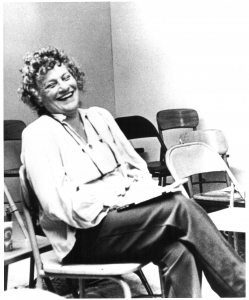Viola Spolin’s Writing Game
Any number of players and one sidecoach
Materials: 4 pieces of paper or one divided into quadrants, pen or pencil
Label each paper 1, 2, 3 and 4. Title #1 My Dream, #2 How To, #3 A Story and #4 A letter (or any 4 disparate subjects or styles of writing. i.e., A memory, A poem, etc.)
Sidecoach calls out a number to the players. Players must begin (without hesitation or forethought) writing on that subject. Writing is to continue non-stop. Points off for hesitating or too much thinking and not writing. After a short interval coach calls another number and players must INSTANTLY SWITCH to that number’s page, writing non-stop on the new subject. Coach will call each number randomly and at intervals under one minute. Players are to switch to each subject called and continue writing where they left off.
Game continues until each player has covered each page with writing.
Focus: To switch instantly between 4 different subjects when coached
Sidecoaching: Keep writing! Don’t plan! No pausing – write continuously!
Points of Observation:
- Each subject requires a different mode of thinking and switching instantly between modes allows access to player’s intuitive areas.
- This is an exercise and not a test. Have fun and push to make switches instantly. Hesitation is bound up with worry that what you write will be evaluated. Judgement causes hesitation. Judgement is subjective and will cancel flow.
- Avoid forethought. Forethought is writing without putting it down.
When I originally played this game, I was struck with not so much with the content of what I produced, but what I was left with after the experience. I felt agile, present and surprised by my own stuff. The information was secondary to the feeling that I was able to leap before looking, talk before thinking and think while doing.
This is the essence of improvisation to create in front of yourself and an audience. When improvising the ultimate goal is to be just as surprised as the audience at what develops out of solving the problem. That is stepping into the not-yet-known and that is where art is born.
